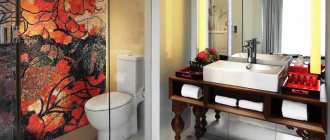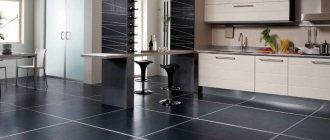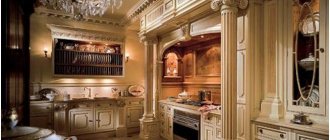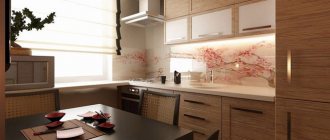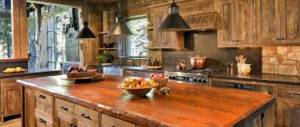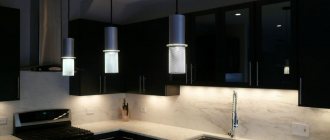Where does zebrawood grow?
This is a typical representative of the tropics. It is most common in the western part of the African continent. It grows especially abundantly in countries such as Congo, Cameroon and Gabon. It looks like a single, wide-branched tree, reaching up to 40 m. The cross-section of the trunk is about 100 cm. The crown begins at a height of 20 m, leaving the entire area from the ground free.
Zebrawood tree
The planting is recognized as exotic and prone to extinction: it is under threat of destruction in the area of its natural growth. Attempts are now underway to urgently restore the number of these trees.
How to combine zebrawood with other colors in the kitchen
White color. Looks good with sandy zebrawood, ideal with dark, almost black. It is not recommended to paint the entire kitchen in white; a work surface, countertop, ceiling and individual elements will suffice.
Beige color. Almost universal beige goes well with any shade of zebrawood, but you should avoid tandems in which the color of the wood itself is also beige: a slight contrast should still be present. Zebrano + beige = a win-win option for those who want to see the kitchen as an oasis of comfort and peace, where nothing hurts the eyes or makes you nervous.
Green color. Pairs perfectly with zebrawood, but with a caveat. It is better to choose emerald green for dark wood, grassy green for sandy wood, dark green for light wood, and gray zebrawood goes best with a marsh or jade shade. Such “woody-herbaceous” cuisines create an atmosphere of wild nature, while calming and toning.
Grey colour. Rarely used in such an exotic setting as a zebrawood interior. Looks best in interiors with gray zebrawood, but in limited quantities. Good in detail, but in large areas it is better to avoid a pure gray tint.
Orange color. Pure, “undiluted” orange is good next to golden and chocolate dark zebrawood, but if you have a kitchen made of light wood, it is better to use a darker shade close to scarlet. This combination is suitable for active people who are depressed by boring pastel colors.
Black color. A classic to be careful with. Black looks elegant and stylish with most varieties of zebrawood, but it is important not to overdo it.
The “bottom” facade or table, work surface, individual elements can be black - otherwise the kitchen will look like a dense cannibal’s lair.
Imagine, plan, think, and everything will work out. Good luck!
Properties
- The kernel is a pale golden hue, clearly separated from the sapwood.
- Features narrow stripes of many color variations (from black to light beige).
- May have spots of varying sizes.
- The structure is a curled plant with wavy and intersecting fibers.
- The texture is firm, heavy and a little rough.
- The dry density of wood is quite high and can reach from 750 to 800 kg per cubic meter.
- Hardness - 4.1 units. (4.1 kgf/sq. mm according to Brinell).
Characteristics of wood
It is incredibly decorative, elite and rare. It has a fine-layer structure. It is characterized by increased strength and wear resistance. It lends itself well to chemical and mechanical treatment (especially grinding and polishing).
It is difficult to dry, requiring special conditions with strict adherence to temperature conditions and technologies. If this is not done, the material will come out cracked and warped. Positive properties include its inedibility for insects, as well as resistance to fungal infections.
Zebrawood texture
It is extremely interesting, due to which the tree has gained high popularity. Double color serves this purpose: distinct dark lines on a light surface make up a continuous picture of different densities. This gives the products bright expressiveness, expressiveness, contrast and dynamics. The stripes run predominantly in the longitudinal direction.
Zebrawood wood texture
There are many variations in color scheme, since the background, like the lines, can vary depending on the region:
- black;
- sand;
- brown;
- light beige;
- grey;
- ginger;
- caramel.
Color palette of natural shades and combinations in the interior
Interior doors veneered with zebrawood texture have a polished surface that is smooth to the touch.
Zebrawood surface after treatment
Such ceilings do not look like glossy doors, but they are part of the interior decoration of an elite level of design. Now, thanks to the fact that interior doors from the manufacturer are available on the construction market, with an exact imitation of the texture of African wood, designs have become more affordable than the average category of consumer population. The natural tones of solid colors are quite varied in nature. Dark stripes passing through a light background are of different tones, or vice versa. Zebrawood colors, tones and undertones can be divided into several specific groups:
- sand tone of zebrawood texture (veins are not endowed with strong contrast);
- light tones (honey halftones with sapwood from brown to black);
- gray shades;
- dark zebrawood (it can be mahogany, brown, or even black).
The peculiar curliness of natural solid wood creates additional difficulties in processing the material, but in the end, it reveals the rich texture of the surface. Each product, veneered with natural raw materials or finished with artificial material imitating zebrawood, is a work of interior art.
Halftone Zebrano
The widest range of shades and halftones allows you to select the required range of colors of the material used for a given interior design. This opens up the possibility of different combinations of the texture of the interior door with the decor of the room, wall decoration and even textiles.
However, the task of choosing the right color tones is quite difficult, even for an experienced designer. Below will be presented in the photo a group of similar zebrawood tones with recommended colors that can be used in the interior.
Refreshing interior sand tones
Doors in Zebrano color sand halftone
First, let's look at the sand shades of texture. The photo shows all the existing and most common options for imitation wood with color combinations that are similar in the palette for a harmonious reunion in the interior. Sand-colored zebrawood veneer doors with large or small stripes are very popular for the following reasons:
- the veins are endowed with a weak contrast with the main tone;
- the surface, thanks to low-contrast stripes, remains exotically attractive, but light;
- Light finishing of small rooms with sand zebrawood increases the space.
Sand Zebrano colors and their color compatibility
Previously, it was believed that exclusively glossy doors could increase spatial freedom in tandem with light walls and flooring. Now we know that light-colored doors in the opening have less visual pressure on the interior space. This fact is very critical, provided that the room is not very large in area. So, interior doors in a sand-colored zebrawood interior will be an additional source of lightening.
Article on the topic: Joint of tiles and laminate: how to join, threshold transition and connection, ceramic and profile
If there are doubts and difficulties in harmoniously combining the design of the room, then the photo shows the primary colors that will perfectly highlight the overlap between adjacent rooms.
Light rich classic
Zebrawood in its classic form may be familiar to many in the light undertones of honey colors. The shades of the light-textured veins are more pronounced in the sand group. They can vary on a single canvas in colors from light brown to black, cutting through light beige or honey-brown sapwood.
Doors in the Zebrano interior in honey tones
The range of tones under consideration is more eccentric, which brings more temperament and exoticism to the interior.
Light doors with pronounced contrasting veining will become the brightest decor in your home. However, you should be careful when choosing exactly this color combination of texture, since a harmonious tandem of flooring and wall decoration is very difficult to determine.
Honey shades of Zebrano in a combination of shading colors
Colorful combinations of suitable colors will add richness to the interior, decorated in a modern style. The rich density of colors in the room is guaranteed, and how to choose the right undertones can be seen in the presented photo.
Gray in retro trends
When deciding to buy interior doors with a zebrawood finish in gray tones, the furnishings of the future design are planned in expensive interior styles. If we look at the gray veneer of exotic wood in more detail, then there are halftones of gray and beige. The popularity of the standard range of shades comes from retro stylistic trends. Retro style in interior decoration mainly uses stained wood of different types.
Zebrano in gray color stands out in style among the uniform design of products
Gray zebrawood veneer doors will allow the cool element of the opening to be diluted with bright, cold details of the interior decoration. Moderately warm colors are also welcome in tandem with gray interior canvases with a pronounced texture. Lovers of formal furnishings and discreet interiors will be pleased by the harmonious combination of gray doors with white walls and black flooring.
Gray undertones in tandem with harmonious colors
In its classic form, zebrawood gray stands out against the backdrop of marsh and purple undertones. An excellent addition would be silver decorative elements, for example, as fittings, or decorative finishing with glass inserts with a silver coating.
Dark tone of sufficiency
Dark zebrawood veneer has a rich and deep color. The bright veins of the natural wood pattern alternate from wide to narrow. A fairly close arrangement of the stripes creates an even deeper tone for the door panels. The background of the material varies in brown colors with a different range of tones: walnut, golden, light mahogany, dark cherry and others.
Related article: Thread curtains for the kitchen - the highlight of the interior
Bright accent in dark trim and Zebrano doors
Dark zebrawood is a very dense color that can be perceived by self-sufficient individuals. Such interior doors in the interior produce the most impressive effect. It is permissible to dilute and shade the ceilings only with the same rich colors and clear lines.
Harmonious combination of wood in dark Zebrano and other colors
If the decision to buy interior doors with zebrawood finish has arisen and become firmly established, it is worth remembering that their use in the interior is a very delicate and unambiguous issue. A balanced atmosphere is required here. The door will create the color itself, but not everyone can shade it correctly.
We recommend avoiding variegation, that is, using only a door with such an expressive wood structure. Coverings and interior decoration can be created from other types of wood with less pronounced texture.
What is zebrawood used for?
Due to its highly decorative and exotic nature, its scope of application is elite. Thus, wood is used to make wall panels, veneer, exclusive design items, marquetry (inlay), furniture, and plywood cladding sheets.
Kitchen made from Zebrawood
Included in the interior trim of expensive cars (for example, Mercedes-Benz). Used for the production of knife handles, ski poles, guitar bodies, billiard cue inserts, and pistol grips.
Basic rules for zebrano kitchen design
The word “zebrano” is not accidental: the wood in cross-section really resembles a zebra in color, since thin fibers of dark and light shades alternate exactly like wool on a zebra’s skin.
Zebrawood is easy to process, is not afraid of pests and, after appropriate treatment, tolerates high humidity and chemicals.
Thanks to such “inclinations”, wood has become widely used in the production of furniture, so today you can buy either a kitchen made of natural zebrawood or one simply lined with zebra veneer - both options have the right to life.
Let's look at the main rules that you need to follow when choosing a zebrawood kitchen.
Rule No. 1. Zebrano should be in moderation. Even without painting and varnishing, this is a very bright material, and if everything is made from it - the set, the table, and the floor - then your eyes will simply dazzle when you enter the kitchen.
The golden rule of the ensemble works here: the main color should appear twice - in a larger element and in an additional detail. This means that the kitchen set itself and, possibly, chairs can be ordered from zebrawood. Or make a wooden “apron” and the floor, leaving the kitchen itself monochromatic, plastic, for example.
Rule No. 2. When combining textures and materials, in addition to zebra, choose plain surfaces. Colorful tiles with lots of details, for example, or cheerful wallpaper that would be appropriate in another kitchen will simply get lost here.
Zebrawood goes well, with the right approach, with almost any color, cold and warm, bright and pastel. This is its obvious advantage, due to the fact that the wood itself has already collected different shades.
Rule No. 3. Combine different types of zebrawood in one kitchen. This is rather an advice, not a rule: it is not necessary to do this, but it will look very impressive.
For example, you can make the upper façade of the kitchen from lighter wood, the lower one from dark wood, combining them with a neutral or, conversely, contrasting “apron”. You can assemble a kitchen in a checkerboard pattern, alternating deep and light shades of zebrawood.
Rule No. 4. You should not experiment with styles - zebrawood will look great in a high-tech, modern or minimalist design, but, to put it mildly, it is inappropriate in a classic kitchen, and even more so in an interior “weighted” with Victorian luxury.
This wood looks too exotic for these styles, so before buying a kitchen you need to carefully think about how the entire room will look. At the same time, you can safely add elements made of plastic, artificial or natural stone, and glass to the zebrawood.

